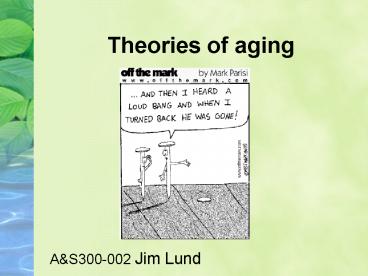Theories of aging PowerPoint PPT Presentation
1 / 18
Title: Theories of aging
1
Theories of aging
- AS300-002 Jim Lund
2
Mechanistic theory How animals age
- OR, What biological process is responsible for
aging? - Complexity of the aging phenotype has led to many
theories that focus on particular aspects of the
phenotype. - These theories dont necessarily compete with one
another.
3
The challenge
- Finding theories that account for the many
aspects of the phenotype. - Needed theory that relates changes in one
biological process to another--that incorporates
many different aspects of the aging phenotype and
relates them to common underlying mechanisms.
4
Mechanistic aging theory
- Theories get evaluated on
- Empirical validity (local evaluation)
- Breadth of phenotypes explained by the theory.
- Example replicative senescence model of aging.
- Doesnt explain aging in post-reproductie tissues
like the brain, or animals like the nematode worm
5
Mechanistic aging theories
- There are a host of mechanistic theories, one
review counted 200. - Typically researchers studying one aspect of
aging would focus on an underlying aspect that
seemed responsible for aging in that tissue, and
then theorize that this process is responsible
for other aspects of aging. - Most theories were soon discarded--they didnt
have much explanatory power.
6
Overview of mechanistic theories
- Somatic mutation
- Genetic damage leads to progressive loss of
potential to make necessary proteins. - DNA damage and DNA repair
- Loss of repair effciency with age leads to
somatic mutation with effects described above. - Error catastophe
- Faulty transcription and/or translation decrease
cellular capacity to a subvital level. - Altered proteins
- Post-translational damage reduces cellular
efficiency.
7
Overview of mechanistic theories
- Dysdifferentiation
- Faulty gene activation-repression results in a
cell synthesizing unnecessary proteins, changing
its differentiation state and disrupting cellular
and tissue function. - Free radicals
- Longevity is inversely proportional to the extent
of oxidative damage directly proportional to
antioxidant defense activity. - Waste accumulation
- Waste products of metabolism (proteins, lipids,
etc) accumulate d and depress cellular efficiency
if not removed or diluted by cellular division.
8
Overview of mechanistic theories
- Post-translational protien changes
- Time-dependent chemical cross-linking of
protein/lipids/sugars impairs cell and tissue
function to a subvital level. - Wear and tear
- Originally focused on ordinary insults and
injuries of daily living. Damage builds up and
decreases organisms functioning to a subvital
level. - Minor role in aging.
- Metabolic mechanisms
- Longevity is inversely proportional to metabolic
rate. Disproven as originally formulated, but
evolved into the mitochondrial free radical
theory. - Genetic mechanisms
- Changes in gene expression cause senescent
changes in cells. May be different in different
cell types, sometime intra-cellular, sometimes
intercellular.
9
Overview of mechanistic theories
- Signaling mechanisms
- Failure of intracellular signaling processes. A
component of several of the other aging theories
dysdifferentiation, neuroendocrine, and
immunological especially. - Neuroendocrine
- Failure of cells with integrative functions leads
to loss of homeostasis, senescence, and death. - Immunological
- Homeostasis depends on proper immune function.
Immune functions are phagocytosis of foreign,
infected, or damaged cells, and regulation of the
neuroendocrine system. Excessive inflammation is
also damaging.
10
Stochastic theories
- Random processes lead to regular changes (aging).
How? - Aging is due to accumulation of random changes.
- Faulty macromolecules accumulate through
- Failure to repair stochastic damage or stochastic
error in macromolecular synthesis. - Progressive accumulation continues until cells
and tissues are so crippled that systemic death
results.
11
Stochastic theories
- Assumptions
- The cell or tissue or organism has certain types
or classes of molecules particularly sensitive to
certain types of damage. - Long-lived species are can better tolerate
molecular damage than short-lived species. - Better repair systems.
- and/or
- Greater functional redundancy.
12
Wear and tear theory
- Early theory, based on observation of the effects
of everyday damage - Evidence against it
- Animals raised in protected environments still
age, have the same maximum lifespan. - Too vague
- Outdated Aspects of this reformulated into more
mechanistic theory that specifies what
macromolecules, what cellular changes are
involved and how they lead to aging.
13
Post-translation protein modifications
- Several types of cross-links and modifications.
- Protein-protein
- Protein-lipid
- Most common type
- Advanced Glycosylation End Products (AGEs).
14
Details of AGE formation
15
Advanced Glycosylation End Products (AGEs).
- Rate depends on oxygen, time, and glucose
concentrations. - Collagen (1/3 of total mammalian protein).
- Collagen is extracellular and has a low turnover
rate. - Cross-link levels increase with age.
- Affects joints, arteries, heart muscle, etc.
- AGEs increase faster in shorter lived rodent
strains than in longer lived strains (Harrison et
al., 1978). - Extracellular AGE crosslinks are recognized and
degraded by macrophages - AGEs affect intracellular proteins and DNA as
well. - DNA repair occurs and protein turnover faster
intracellularly. - More AGEs in Type I diabetics.
- Cross-links slowed by caloric restriction and
exercise (Masoro et al., 1989).
16
Altered protein theory
- Changes to proteins impairs cellular process in a
progressive manner until subvital levels. - Initial evidence observed
- Catalytic activity of many enzymes decreases
25-50 in older animals.
17
Altered protein theory
- Reduced protein function due to several types of
post-translational changes - Denaturation of proteins (can be heated/cooled to
refold restore function). - Covalent modifications
- protein carbonyl levels higher in old animals
- Other protein modifications.
- In an old animal, oxidized protein is 30-50 of
total protein (Berlett and Stadtman, 1997).
18
Altered protein theory
- Protein turnover slows down as animals age
- Protein synthesis rate is reduced.
- Cytoplasmic protein degradation pathway activity
is reduced. - This increases protein half-life (the time
proteins exist) and increases total protein
damage levels.

